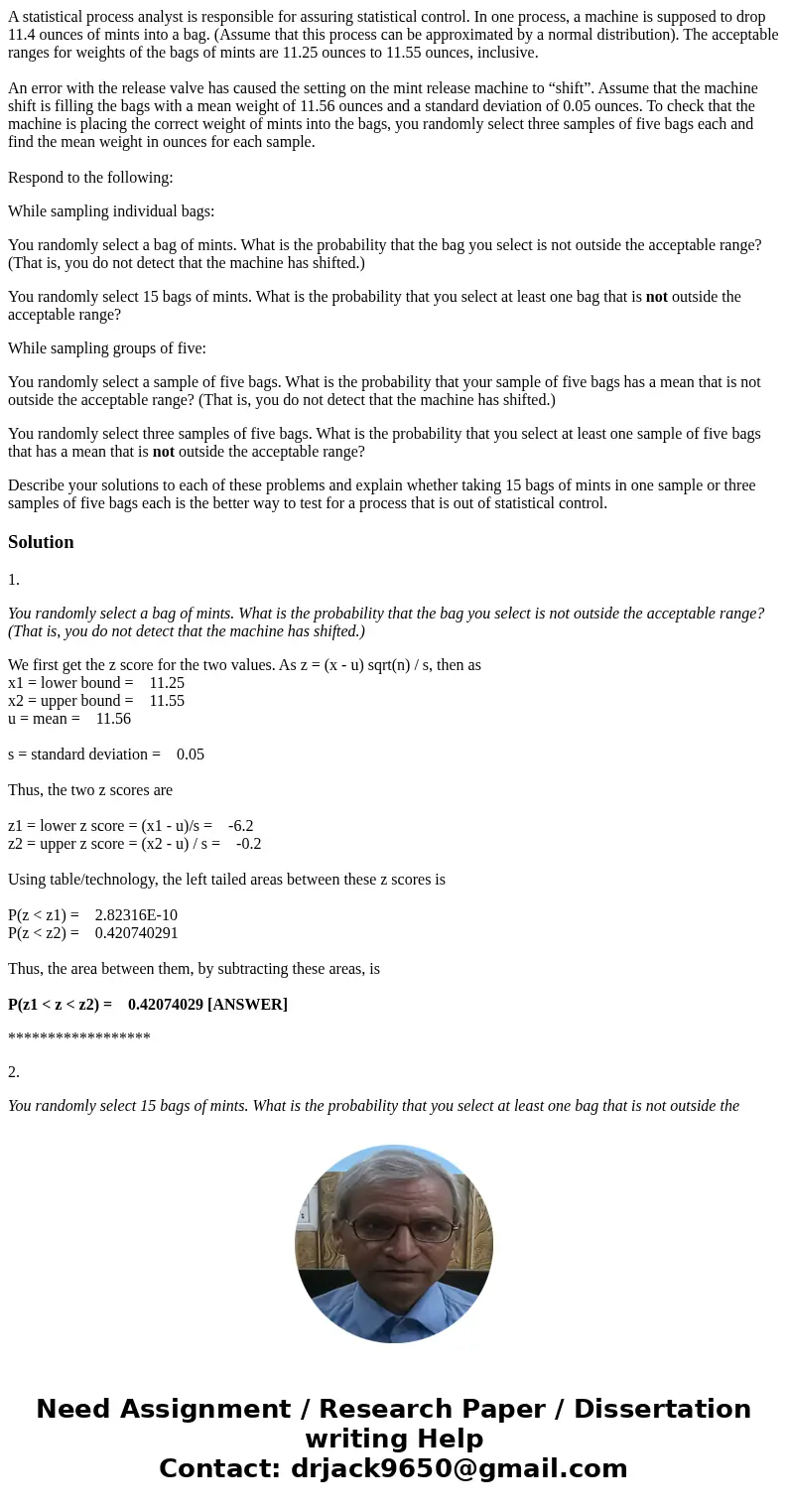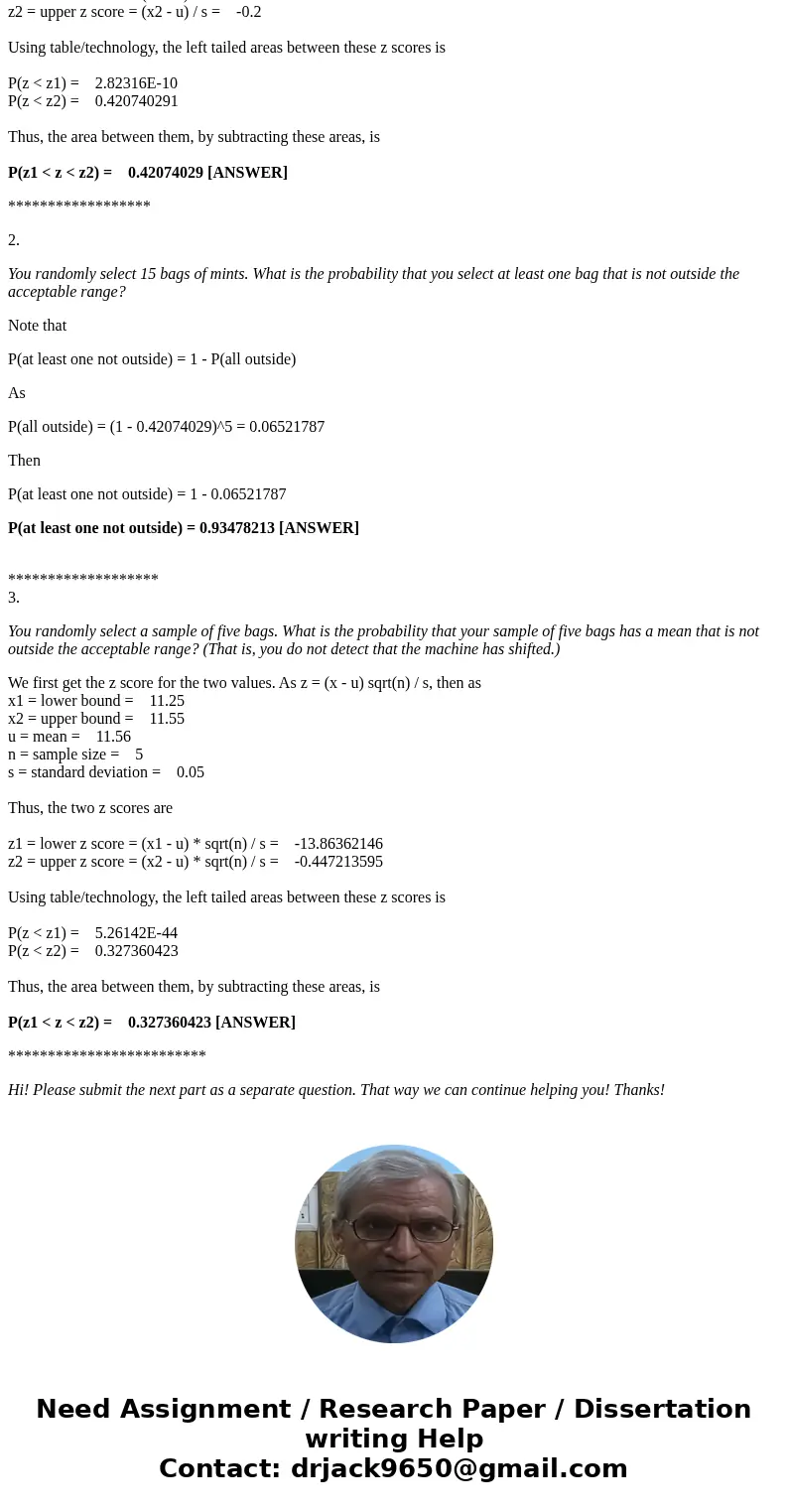A statistical process analyst is responsible for assuring st
A statistical process analyst is responsible for assuring statistical control. In one process, a machine is supposed to drop 11.4 ounces of mints into a bag. (Assume that this process can be approximated by a normal distribution). The acceptable ranges for weights of the bags of mints are 11.25 ounces to 11.55 ounces, inclusive.
An error with the release valve has caused the setting on the mint release machine to “shift”. Assume that the machine shift is filling the bags with a mean weight of 11.56 ounces and a standard deviation of 0.05 ounces. To check that the machine is placing the correct weight of mints into the bags, you randomly select three samples of five bags each and find the mean weight in ounces for each sample.
Respond to the following:
While sampling individual bags:
You randomly select a bag of mints. What is the probability that the bag you select is not outside the acceptable range? (That is, you do not detect that the machine has shifted.)
You randomly select 15 bags of mints. What is the probability that you select at least one bag that is not outside the acceptable range?
While sampling groups of five:
You randomly select a sample of five bags. What is the probability that your sample of five bags has a mean that is not outside the acceptable range? (That is, you do not detect that the machine has shifted.)
You randomly select three samples of five bags. What is the probability that you select at least one sample of five bags that has a mean that is not outside the acceptable range?
Describe your solutions to each of these problems and explain whether taking 15 bags of mints in one sample or three samples of five bags each is the better way to test for a process that is out of statistical control.
Solution
1.
You randomly select a bag of mints. What is the probability that the bag you select is not outside the acceptable range? (That is, you do not detect that the machine has shifted.)
We first get the z score for the two values. As z = (x - u) sqrt(n) / s, then as
x1 = lower bound = 11.25
x2 = upper bound = 11.55
u = mean = 11.56
s = standard deviation = 0.05
Thus, the two z scores are
z1 = lower z score = (x1 - u)/s = -6.2
z2 = upper z score = (x2 - u) / s = -0.2
Using table/technology, the left tailed areas between these z scores is
P(z < z1) = 2.82316E-10
P(z < z2) = 0.420740291
Thus, the area between them, by subtracting these areas, is
P(z1 < z < z2) = 0.42074029 [ANSWER]
******************
2.
You randomly select 15 bags of mints. What is the probability that you select at least one bag that is not outside the acceptable range?
Note that
P(at least one not outside) = 1 - P(all outside)
As
P(all outside) = (1 - 0.42074029)^5 = 0.06521787
Then
P(at least one not outside) = 1 - 0.06521787
P(at least one not outside) = 0.93478213 [ANSWER]
*******************
3.
You randomly select a sample of five bags. What is the probability that your sample of five bags has a mean that is not outside the acceptable range? (That is, you do not detect that the machine has shifted.)
We first get the z score for the two values. As z = (x - u) sqrt(n) / s, then as
x1 = lower bound = 11.25
x2 = upper bound = 11.55
u = mean = 11.56
n = sample size = 5
s = standard deviation = 0.05
Thus, the two z scores are
z1 = lower z score = (x1 - u) * sqrt(n) / s = -13.86362146
z2 = upper z score = (x2 - u) * sqrt(n) / s = -0.447213595
Using table/technology, the left tailed areas between these z scores is
P(z < z1) = 5.26142E-44
P(z < z2) = 0.327360423
Thus, the area between them, by subtracting these areas, is
P(z1 < z < z2) = 0.327360423 [ANSWER]
*************************
Hi! Please submit the next part as a separate question. That way we can continue helping you! Thanks!


 Homework Sourse
Homework Sourse